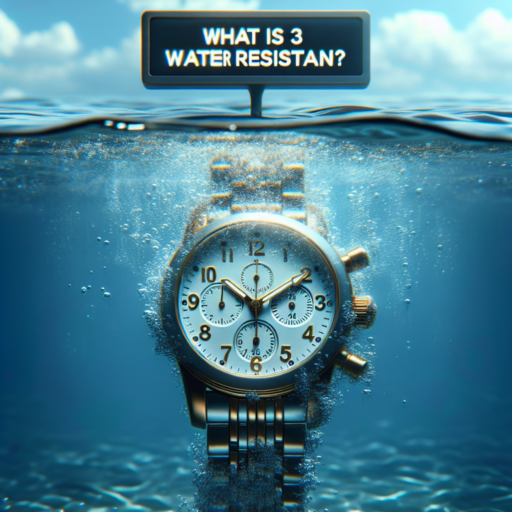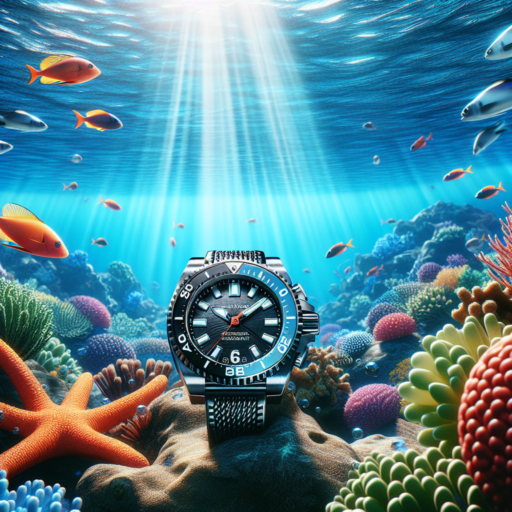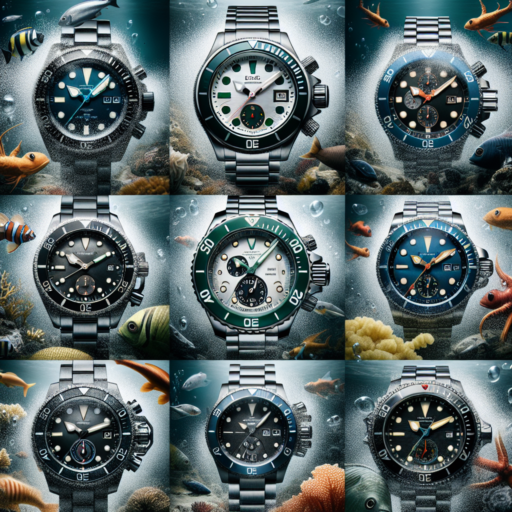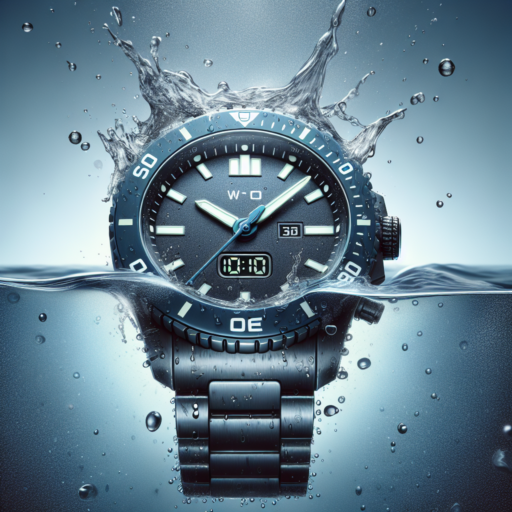Understanding What 3 ATM Water Resistance Really Means
When you encounter a watch labeled as 3 ATM water resistance, it signifies that the timepiece is designed to withstand pressures equivalent to a depth of 30 meters (or roughly 100 feet) under water. However, this does not necessarily mean that the watch can be used for diving or even swimming at such depths. The term «ATM» stands for atmospheres, a measurement unit of pressure used to test water resistance capabilities in watches. It’s crucial for potential buyers to understand what this specification really indicates about the watch’s durability and suitability for various activities.
Firstly, the 3 ATM rating primarily addresses the watch’s ability to resist water ingress during everyday occurrences, such as handwashing or rain. It’s a basic level of protection that ensures moisture does not seep into the timepiece during minor and incidental contact with water. However, activities that increase pressure on the watch, like swimming or showering, can exceed the resistance provided by a 3 ATM rating. Hence, while it might seem sufficient for light water exposure, it’s unsuitable for prolonged or intense water activities.
Moreover, understanding the testing conditions under which the 3 ATM rating is granted can help users gauge the practical implications of this specification. Watches are tested in static or near-static conditions to determine their water resistance. Consequently, the real-world allowances for water exposure are significantly less than what the 3 ATM might seem to promise. Movements in water, such as swimming strokes, can amplify the pressure on the watch well beyond the static pressure of 30 meters depth, which is crucial to know for those who lead active lifestyles or seek a watch for water sports.
The Science Behind 3 ATM Water Resistance and Your Devices
Understanding the term «3 ATM Water Resistance» is crucial for anyone keen on maintaining their electronic devices, especially those we commonly use and bring near water, like watches, fitness trackers, and smartwatches. This specification is not as straightforward as it might seem. It involves an intricate balance of engineering precision and understanding of environmental physics. However, what exactly does 3 ATM mean, and how does it apply to the everyday functionality and longevity of our beloved gadgets?
The Fundamentals of Water Resistance Ratings
At its core, the «3 ATM» label indicates that a device is resistant to water pressure equivalent to that at a depth of 30 meters underwater. This rating is derived from tests performed in static, or non-moving, water conditions. It’s essential to note that these conditions are significantly different from moving water, such as swimming or fast streams, where water pressure on a device would significantly increase. Furthermore, manufacturers calculate this rating based on the premise that the device’s seals and manufacturing integrity remain uncompromised over time, which emphasizes the role of maintenance and regular checks.
How It Affects Your Devices
The science behind the 3 ATM rating is as much about preventing water molecules from entering a device as it is about handling pressure. When manufacturers design a product to be water resistant, they’re not only sealing it tightly; they’re also selecting materials that are less permeable to water. This meticulous process ensures that sensitive internal components are safeguarded against corrosion and short-circuiting, which is particularly important to maintain the device’s functionality and safety. Knowing the boundaries of your device’s water resistance capability can significantly prevent unintentional damage.
How to Test if Your Watch is Really 3 ATM Water Resistant
Testing if your watch is genuinely 3 ATM water resistant is crucial to ensure its durability and functionality in wet conditions. This standard means that your watch is supposedly safe to use at depths up to 30 meters, but it’s primarily intended for accidental splashes or brief immersion in water, not for swimming or diving. To verify this feature, follow a few tested methods but proceed with caution to avoid accidental damage.
Understanding 3 ATM Water Resistance
Before conducting any tests, it’s important to understand what 3 ATM water resistance means. The term «ATM» (atmospheres) refers to the amount of pressure your watch can withstand. Despite the literal translation suggesting deeper water activities, 3 ATM watches are often only recommended for everyday use with minimal water exposure. Knowing this will help you set realistic expectations during testing.
Conducting a Dry Test
A simple yet effective method to start with is the dry test. Place your watch under a lamp or in direct sunlight for about an hour to warm it up. Afterwards, place the warmed watch on a cold surface or wrap it in a cold, damp cloth. If you notice any condensation forming inside the watch face, this could indicate compromised water resistance. This test mimics the sudden temperature changes often experienced when entering water, making it a good preliminary test that doesn’t involve water immersion.
Professional Water Resistance Verification
If you prefer not to take any risks, consulting a professional watchmaker or a service center is the safest way to test your watch’s water resistance up to 3 ATM. Qualified technicians have the equipment to simulate water pressure conditions in a controlled environment, accurately assessing whether your watch lives up to its water-resistant claims. This method prevents unnecessary exposure to water and potential damage to your timepiece.
Testing your watch for 3 ATM water resistance can help in maintaining its longevity and ensuring it performs as expected. While it’s tempting to conduct immersion tests, starting with less invasive methods and consulting professionals will provide peace of mind without risking damage to your valuable accessory.
The Do’s and Don’ts of Caring for Your 3 ATM Water Resistant Devices
Understanding the care guidelines for 3 ATM water resistant devices is crucial in maintaining their longevity and functionality. While these devices are designed to withstand splashes or rain, they are not invincible. This guide outlines the essential do’s and don’ts to ensure your gadget remains in top condition.
Do’s
- Clean Regularly: Gently wipe your device with a soft, lint-free cloth to remove dust, sweat, or any other residue. This is especially important after exposure to saltwater or chlorine.
- Read the Manufacturer’s Instructions: Always follow the specific care guidelines provided by the device manufacturer to avoid accidental damage.
- Dry Thoroughly: If your device gets wet, dry it completely with a soft cloth. Do not expose it to direct heat sources to speed up the drying process.
Don’ts
- Avoid Pressing Buttons Underwater: Even if your device is water resistant, pressing buttons while it is submerged can compromise its seal and allow water to enter.
- Do Not Expose to Extreme Temperatures: Exposing your device to high temperatures or drastic temperature changes can damage its water-resistant seal.
- Refrain from Opening: Opening your device for any reason can void its warranty and impact its water resistance capability. Leave any repairs to professionals.
Comparing 3 ATM, 5 ATM, and 10 ATM Water Resistance: What’s the Difference?
Understanding the differences between 3 ATM, 5 ATM, and 10 ATM water resistance ratings is crucial for choosing the right watch for your lifestyle and activities. Each rating specifies the level of water pressure the watch can withstand, but interpreting these numbers and making an informed decision requires a deeper dive into what each level actually means in practical terms.
3 ATM water resistance is often found in fashion watches and signifies that a watch can withstand splashes or brief immersion in water, such as hand washing or light rain. It’s important to note that 3 ATM watches are not suitable for swimming or bathing. On the other hand, 5 ATM water resistance offers a higher level of protection, making these watches appropriate for showering and short periods of swimming in shallow water. However, diving, snorkeling, or water sports might still pose a risk to these watches.
Moving up the scale, 10 ATM water resistance signifies a watch that is suitable for a range of water activities, including swimming, snorkeling, and other shallow-water sports. Although these watches offer significant protection against water ingress, it’s essential to understand that they are not designed for deep-sea diving. The distinction between these ratings highlights the importance of choosing a watch that aligns with your typical water exposure and activities.
No se han encontrado productos.
Top 5 Myths About 3 ATM Water Resistance Busted
When it comes to watches and their features, water resistance ranks among the most misunderstood. Specifically, the concept of 3 ATM (atmospheres) water resistance is shrouded in myths that often lead consumers astray. Understanding what 3 ATM truly signifies is crucial in making informed decisions about which watch suits your lifestyle needs. Let’s dive into debunking the top myths surrounding 3 ATM water resistance.
Myth #1: 3 ATM Watches Are Suitable for Swimming
One common misconception is that a watch labeled as 3 ATM water-resistant means it’s perfectly fine for swimming. However, a 3 ATM rating primarily indicates that the watch can withstand splashes or brief immersion in water, such as hand washing or rain. Activities that involve water pressure, including swimming, can exceed the threshold that a 3 ATM watch can handle, potentially leading to water damage.
Myth #2: All Water-Resistant Watches Are Created Equal
Another myth worth addressing is the belief that all water-resistant watches offer the same level of protection, regardless of their ATM rating. It’s important to note that water resistance is measured in atmospheres (ATM), with each level serving a specific purpose. A 3 ATM rating offers less protection against water ingress compared to higher ratings like 5 ATM or 10 ATM, which are more suited for swimming or diving activities.
Myth #3: Water Resistance Is Permanent
Many consumers also mistakenly believe that once a watch is labeled as 3 ATM water-resistant, it retains this feature indefinitely. In reality, water resistance can diminish over time due to wear and tear, exposure to chemicals, or after having the watch serviced. Regular checks and maintenance are essential to ensure that your 3 ATM water-resistant watch continues to provide the expected level of protection against water.
What Activities are Safe for Your 3 ATM Water Resistant Watch?
Understanding the capabilities of your 3 ATM water resistant watch is crucial in maintaining its longevity and functionality. The term «3 ATM» refers to the watch’s resistance to pressure up to 3 atmospheres, which translates to a resistance against water at a depth of up to 30 meters. However, this rating does not necessarily mean the watch can be used for all activities involving water.
Everyday Use and Light Water Exposure
For day-to-day activities, a 3 ATM water resistant watch is highly suitable. It can withstand episodes of light water exposure such as rain or hand-washing. These actions pose no threat to the integrity of your watch, making it a reliable accessory for everyday use. Essentially, the watch is designed to cope with splashes rather than immersion, safeguarding its internal components from moisture damage during routine activities.
Swimming and Diving: Proceed with Caution
When it comes to swimming or diving, the limitations of a 3 ATM water resistant watch become apparent. While some might assume that a resistance level up to 30 meters depth would be sufficient for swimming, it’s important to understand that dynamic movement can increase pressure on the watch, potentially surpassing the 3 ATM threshold. Consequently, it’s advisable to avoid engaging in these activities while wearing your watch to prevent compromising its water resistance capability.
In summary, the safest activities for your 3 ATM water resistant watch involve everyday use, where it is exposed to minimal amounts of water. It’s important to remember that these watches are not designed for water sports or activities that involve significant water immersion. Treating your watch within these guidelines will ensure its longevity and preserve its functionality.
3 ATM Water Resistance Warranty: Understanding Your Coverage
When purchasing a timepiece marked with a 3 ATM water resistance warranty, it’s crucial to understand exactly what this specification means for the durability and usability of your watch in daily scenarios. Traditionally, this level of resistance signifies that the watch can withstand pressures equivalent to a depth of 30 meters or approximately 100 feet underwater. However, the terminology can be somewhat deceptive for the average consumer.
The practical implications of a 3 ATM rating might not be what you initially expect. Despite the connotations of being able to survive depths of up to 30 meters, this rating essentially means that the watch is suitable for everyday use and can withstand splashes of water, such as washing your hands or rain. It is not designed for swimming, diving, or engaging in water sports. The pressure exerted on the watch during such activities could exceed the boundaries of its 3 ATM rating, leading to potential water damage.
Understanding the warranty coverage for your 3 ATM water-resistant watch is equally important. While the watch is certified to resist moisture to a certain degree, the warranty may not cover all forms of water damage. It’s essential to review the warranty details provided by the manufacturer closely. Often, warranties will protect against defects in materials and craftsmanship but might not extend to cover damages incurred during water-related activities that exceed the advised limitations of the watch’s water resistance rating.
To maximize the longevity of your 3 ATM water-resistant watch and ensure you are adequately covered, it’s advisable to adhere to the recommended usage guidelines and understand the specific terms of your warranty. This proactive approach will help prevent any disappointment or misunderstandings should your watch face unexpected exposure to water.
Water Damage: Is Your 3 ATM Water Resistant Device Really Protected?
When it comes to safeguarding our electronic devices, the term «3 ATM water resistant» offers a sense of security. But the question remains, how protected is your 3 ATM water resistant device against water damage? Unveiling the capabilities and limitations of this rating will ensure that your expectations match reality, preventing undesirable surprises.
The label 3 ATM (atmospheres) suggests that a device can withstand pressures equivalent to those found at 30 meters (about 100 feet) underwater. At first glance, this rating implies that taking your 3 ATM device for a shallow swim should pose no threat. However, it’s crucial to understand that this testing is conducted under ideal and static conditions, which hardly mirror real-life scenarios such as moving in the water or changing water temperatures.
Understanding the Gap between Lab Tests and Real-World Usage
Lab tests for 3 ATM water resistance do not account for all aspects of real-world use. Factors such as swimming strokes, shower jets, or sudden changes in depth can significantly increase pressure on the device, challenging its water resistance capabilities. This means that activities you might consider safe based on the 3 ATM rating might actually pose a risk to your device.
Moreover, it’s essential to be aware that water resistance is not a permanent feature. Over time, the seals that protect a device can weaken due to wear and tear, exposure to chemicals, or temperature changes, eroding its defense against water intrusion. Regular maintenance is crucial to ensure that the 3 ATM rating continues to provide the intended level of protection.




